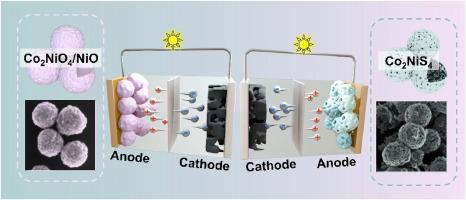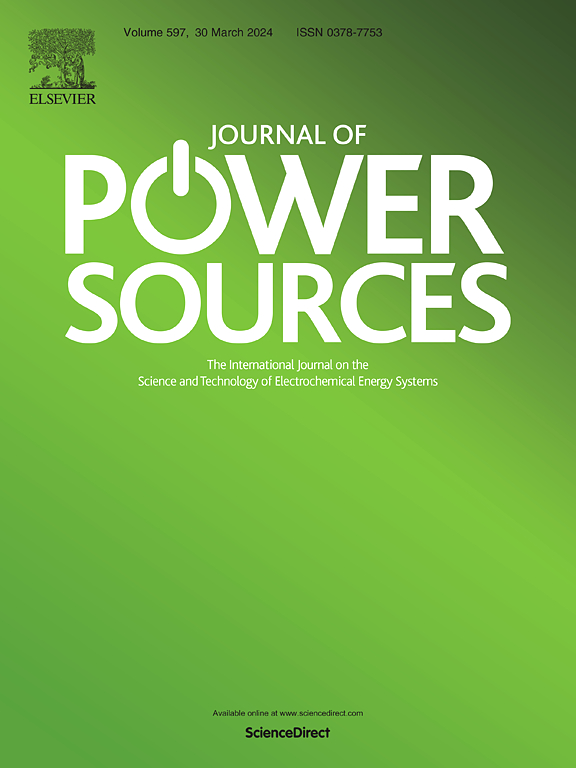Nanostructure engineering of cobalt-nickel glycerate (CoNi-G) spheres as anodes for constructing high-performance lithium-ion capacitors
IF 8.1
2区 工程技术
Q1 CHEMISTRY, PHYSICAL
引用次数: 0
Abstract
Electrode materials with heterogeneous structure and favorable morphology can increase the contact with the electrolyte while accelerating the ion transport. Here, we prepared Co2NiO4/NiO solid spheres and CoNi2S4 hollow spheres by high-temperature calcined oxidation and solvent-thermal vulcanization, with cobalt-nickel glycerate (CoNi-G) solid spheres as precursors, respectively. The specific capacities of Co2NiO4/NiO and CoNi2S4 as anodes after 170 and 570 cycles at 0.1 A g−1 are 1260.9 mAh g−1 and 495.0 mAh g−1 respectively, and even after 3000 cycles at 2 A g−1, their specific capacities can reach 168.9 mAh g−1 and 211.1 mAh g−1 respectively. The initial specific capacities of both materials are higher, but the solid structure is more stable than the hollow structure. Density Functional Theory (DFT) calculations show that the constructed Co2NiO4/NiO heterojunction has reduced Li+ embedding formation energy and enhanced conductivity. Finally, the assembled Co2NiO4/NiO//AC and CoNi2S4//AC lithium-ion capacitors have maximum energy densities of 106.7 Wh kg−1 and 73.6 Wh kg−1 (at 205 W kg−1 and 95 W kg−1), and maximum power densities of 20.5 kW kg−1 and 19.0 kW kg−1 (at 10.8 Wh kg−1 and 19.5 Wh kg−1). Improved electrode structures via precursor treatments enhance lithium-ion capacitors performance, suggesting new avenues for material research.

甘油酸钴镍(CoNi-G)球的纳米结构工程,作为构建高性能锂离子电容器的阳极
具有异质结构和良好形貌的电极材料可以增加与电解质的接触,同时加速离子传输。在此,我们以甘油酸钴-镍(CoNi-G)固态球为前驱体,分别采用高温煅烧氧化法和溶剂热硫化法制备了Co2NiO4/NiO固态球和CoNi2S4空心球。Co2NiO4/NiO 和 CoNi2S4 作为阳极,在 0.1 A g-1 下循环 170 次和 570 次后,比容量分别为 1260.9 mAh g-1 和 495.0 mAh g-1,即使在 2 A g-1 下循环 3000 次后,比容量也分别达到 168.9 mAh g-1 和 211.1 mAh g-1。两种材料的初始比容量都较高,但实心结构比空心结构更稳定。密度泛函理论(DFT)计算表明,所构建的 Co2NiO4/NiO 异质结具有更低的 Li+ 嵌入形成能和更高的导电性。最后,组装好的 Co2NiO4/NiO//AC 和 CoNi2S4//AC 锂离子电容器的最大能量密度分别为 106.7 Wh kg-1 和 73.6 Wh kg-1(205 W kg-1 和 95 W kg-1),最大功率密度分别为 20.5 kW kg-1 和 19.0 kW kg-1(10.8 Wh kg-1 和 19.5 Wh kg-1)。通过前驱体处理改进电极结构可提高锂离子电容器的性能,为材料研究提供了新的途径。
本文章由计算机程序翻译,如有差异,请以英文原文为准。
求助全文
约1分钟内获得全文
求助全文
来源期刊

Journal of Power Sources
工程技术-电化学
CiteScore
16.40
自引率
6.50%
发文量
1249
审稿时长
36 days
期刊介绍:
The Journal of Power Sources is a publication catering to researchers and technologists interested in various aspects of the science, technology, and applications of electrochemical power sources. It covers original research and reviews on primary and secondary batteries, fuel cells, supercapacitors, and photo-electrochemical cells.
Topics considered include the research, development and applications of nanomaterials and novel componentry for these devices. Examples of applications of these electrochemical power sources include:
• Portable electronics
• Electric and Hybrid Electric Vehicles
• Uninterruptible Power Supply (UPS) systems
• Storage of renewable energy
• Satellites and deep space probes
• Boats and ships, drones and aircrafts
• Wearable energy storage systems
 求助内容:
求助内容: 应助结果提醒方式:
应助结果提醒方式:


